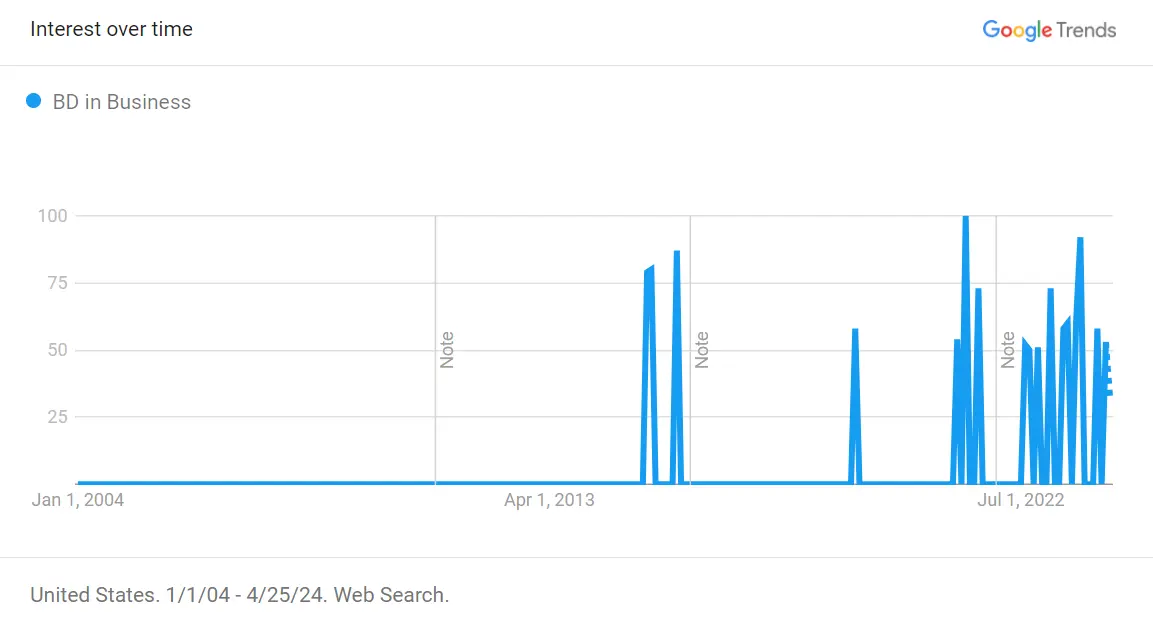With the introduction of ever-evolving ideas and technologies in the commercial landscape, businesses are perpetually on the lookout for avenues to ensure growth and sustainability.
One indispensable avenue in this search for betterment is Business Development (BD). The idea might seem vague at first and too broad to cover, but improving your understanding of BD can help you make better decisions and plan for the future.
Here’s a breakdown of what it means in business, its implications, strategies, and opportunities for BD.
What Does BD Mean in Business?

Business Development encompasses a spectrum of activities aimed at enhancing the long-term value of a company.
At its core, BD involves identifying opportunities, nurturing relationships, and driving growth. It serves as a proactive approach to expanding market presence, increasing revenue streams, and fostering innovation within an organization.
Why BD is Important for a Business
BD plays a pivotal role in the success of any business. It serves as a catalyst for growth by identifying new markets, forging strategic partnerships, and maximizing existing resources.
- Revenue Generation: BD efforts directly contribute to revenue generation by identifying new business opportunities, expanding market presence, and driving sales growth.
- Market Expansion: BD activities focus on penetrating new markets, both domestically and internationally, to diversify customer base and reduce dependency on specific regions or sectors.
- Strategic Partnerships: Forming strategic partnerships allows businesses to leverage complementary strengths, resources, and networks, leading to mutual benefits such as increased market reach and economies of scale.
- Customer Acquisition: BD plays a vital role in acquiring new customers through targeted marketing campaigns, lead generation activities, and relationship building initiatives.
- Competitive Advantage: By differentiating products or services, optimizing pricing strategies, and capitalizing on unique strengths, BD helps businesses gain a competitive edge in the marketplace.
- Innovation and Adaptability: BD fosters innovation by identifying emerging trends, customer needs, and technological advancements, enabling businesses to adapt quickly and stay ahead of the competition.
- Risk Mitigation: Proactive BD initiatives help businesses anticipate market changes, mitigate risks, and diversify revenue streams, reducing vulnerability to economic downturns or industry disruptions.
- Long-Term Growth: BD is essential for sustainable long-term growth, as it focuses on building strong customer relationships, expanding market presence, and seizing opportunities for expansion and diversification.
How BD Works Within an Organization
Following steps highlight how business development works within different organizations such as those belonging to sales and marketing, legal and finance industry, project management, business planning, product management and manufacturing, and more.
- Market Analysis: BD starts with a thorough analysis of the market landscape, including industry trends, competitor activities, and customer preferences. This analysis helps identify gaps, untapped opportunities, and potential areas for expansion.
- Goal Setting: Based on the market analysis, BD professionals work with key stakeholders to set clear and measurable goals. These goals may include revenue targets, market share growth, or expansion into new geographic regions or market segments.
- Strategic Planning: BD professionals develop strategic plans to achieve the organization’s goals. This involves outlining specific initiatives, allocating resources, and defining timelines for implementation.
- Lead Generation: BD activities often involve generating leads through various channels such as networking events, industry conferences, digital marketing, and partnerships. These leads are then qualified and prioritized based on their potential to contribute to the organization’s growth objectives.
- Relationship Building: Building and nurturing relationships is a critical aspect of BD. This includes cultivating relationships with potential clients, strategic partners, industry influencers, and other stakeholders. Strong relationships facilitate collaboration, trust, and opportunities for mutual benefit.
- Proposal Development: BD professionals prepare proposals and presentations to pitch products or services to potential clients or partners. These proposals highlight the value proposition, unique selling points, and benefits of working with the organization.
- Negotiation and Closing Deals: BD professionals engage in negotiation with prospective clients or partners to finalize terms and agreements. This may involve pricing discussions, contract negotiations, and addressing any concerns or objections raised by the other party.
- Post-Sales Support: After securing new business or partnerships, BD professionals continue to provide support to ensure a smooth transition and ongoing satisfaction. This may involve addressing any issues or concerns, facilitating onboarding processes, and maintaining regular communication to nurture long-term relationships.
- Performance Evaluation: BD efforts are continuously monitored and evaluated to assess their effectiveness in achieving the organization’s goals. Key performance indicators (KPIs) such as revenue growth, customer acquisition cost, and conversion rates are tracked to measure success and identify areas for improvement.
- Adaptation and Optimization: BD strategies are adjusted and optimized based on feedback, market changes, and evolving business objectives. This iterative process ensures that the organization remains agile and responsive to shifting dynamics in the marketplace.
Find Out More: What are Foil Accent Business Cards? Types and How to Design
Opportunities for Business Development
You can identify spaces for growth in your business structure by conducting a keen analysis. Here’s a list of factors that signal an opportunity for business development.
- Market Expansion: Identifying and entering new geographic markets or market segments where there is untapped demand for products or services.
- Product or Service Diversification: Expanding the range of offerings to cater to different customer needs or to enter complementary markets.
- Partnership and Alliances: Forming strategic partnerships with other companies or organizations to leverage complementary strengths, access new markets, or share resources.
- Customer Segmentation: Identifying specific customer segments with unique needs or preferences and tailoring products or services to better meet their requirements.
- Channel Development: Exploring new distribution channels or sales channels to reach customers more effectively, such as e-commerce platforms, distribution partnerships, or direct sales.
- International Expansion: Expanding operations beyond domestic markets to international markets where there is potential for growth and profitability.
- Innovation and Technology Adoption: Investing in research and development to innovate new products or services, or adopting new technologies to improve efficiency, enhance customer experience, or create new revenue streams.
- Acquisitions and Mergers: Acquiring or merging with other companies to gain access to new markets, technologies, or talent, and to achieve economies of scale.
- Brand Building and Marketing: Investing in brand building activities and marketing campaigns to increase brand awareness, attract new customers, and differentiate from competitors.
- Customer Retention and Loyalty: Implementing strategies to enhance customer satisfaction, improve customer retention rates, and foster customer loyalty through loyalty programs, personalized services, and exceptional customer support.
- Vertical Integration: Expanding operations upstream or downstream in the value chain to gain more control over the production process, reduce costs, or capture additional value.
- Strategic Alliances: Forming alliances with industry associations, trade groups, or government agencies to access resources, expertise, or market intelligence that can support business growth.
- Supply Chain Optimization: Optimizing the supply chain to improve efficiency, reduce costs, and enhance flexibility in responding to changing market demands.
- Sustainability and Corporate Social Responsibility (CSR): Incorporating sustainability practices and CSR initiatives into business operations to attract environmentally conscious consumers, enhance brand reputation, and drive long-term value creation.
- Data Analytics and Business Intelligence: Leveraging data analytics and business intelligence tools to gain insights into customer behavior, market trends, and competitive dynamics, and to inform strategic decision-making.
Steps to Develop a Business Development Plan
Developing a good business development plan rests on the scale, niche, and aim of your business. Consider things one step at a time and cover every aspect of your business.
Step 1: Assess Current Situation
- Conduct a thorough assessment of your organization’s current position in the market.
- Perform a SWOT analysis (Strengths, Weaknesses, Opportunities, Threats) to identify internal strengths and weaknesses, as well as external opportunities and threats.
- Evaluate past performance, market share, customer satisfaction, and competitive positioning to gain insights into your organization’s strengths and weaknesses.
Step 2: Define Goals and Objectives
- Clearly define the goals and objectives you aim to achieve through your Business Development efforts.
- Ensure that your goals are specific, measurable, achievable, relevant, and time-bound (SMART).
- Examples of goals include increasing market share, expanding into new markets, launching new products or services, or improving customer retention rates.
Step 3: Identify Target Markets and Segments
- Identify the target markets and customer segments that align with your organization’s goals and objectives.
- Consider factors such as demographics, psychographics, geography, and purchasing behavior when defining your target audience.
- Segment your target market based on characteristics such as age, gender, income level, preferences, and needs.
Step 4: Conduct Market Research
- Conduct thorough market research to understand market trends, customer needs, competitor activities, and industry dynamics.
- Gather data and insights through surveys, interviews, focus groups, and secondary research sources such as industry reports, market studies, and competitor analysis.
- Analyze market trends, customer behavior, competitive positioning, and emerging opportunities to inform your Business Development strategies.
Step 5: Develop Strategies and Tactics
- Based on your goals, objectives, and market research findings, develop strategies and tactics to achieve them.
- Define specific initiatives, action plans, and timelines for implementation.
- Consider factors such as product development, pricing strategy, distribution channels, promotional activities, and sales tactics when developing your strategies.
Step 6: Allocate Resources
- Determine the resources required to execute your Business Development Plan effectively.
- Allocate budget, personnel, and other resources based on the priorities and requirements of your plan.
- Consider factors such as staffing needs, technology investments, marketing expenses, and other operational costs when allocating resources.
Step 7: Build Partnerships and Relationships
- Identify potential partners, collaborators, and stakeholders who can support your Business Development initiatives.
- Build and nurture relationships with key industry players, customers, suppliers, and other relevant parties.
- Explore opportunities for strategic partnerships, alliances, joint ventures, or co-marketing initiatives to enhance your Business Development efforts.
Step 8: Create a Sales and Marketing Plan
- Develop a comprehensive sales and marketing plan to promote your products or services, generate leads, and drive revenue growth.
- Define your target audience, messaging, channels, and tactics for reaching and engaging potential customers.
- Consider integrating digital marketing strategies, social media campaigns, content marketing, email marketing, and other promotional activities into your plan.
Step 9: Measure and Track Progress
- Establish key performance indicators (KPIs) and metrics to measure the success of your Business Development Plan.
- Regularly track and evaluate your progress against these metrics to identify areas of success and areas for improvement.
- Use tools such as performance dashboards, analytics platforms, and CRM systems to monitor and analyze your Business Development activities.
Step 10: Review and Adapt
- Regularly review and evaluate your Business Development Plan to ensure that it remains aligned with your organization’s goals and objectives.
- Adapt your strategies and tactics based on feedback, market changes, and evolving business needs.
- Continuously monitor market trends, competitor activities, and customer feedback to identify opportunities for optimization and refinement of your Business Development strategies.
Challenges in BD
Here are the most crucial challenges in Business Development (BD):
- Market Saturation: In highly competitive markets, standing out and gaining market share can be challenging due to saturation and intense competition.
- Managing Competition: Dealing with aggressive competitors who may undercut prices, offer similar products/services, or engage in aggressive marketing tactics can pose significant challenges.
- Adapting to Changing Trends: Rapid changes in technology, consumer preferences, and market dynamics require constant adaptation and agility to stay relevant and competitive.
- Globalization: Expanding into international markets brings complexities such as cultural differences, regulatory challenges, and geopolitical risks that must be navigated effectively.
- Resource Constraints: Limited resources, including budget, manpower, and time, can restrict the ability to pursue all potential opportunities and execute BD strategies effectively.
- Risk Management: Assessing and mitigating risks associated with new ventures, partnerships, or market expansions is crucial to avoid potential losses and setbacks.
- Long Sales Cycles: BD initiatives often involve long sales cycles, particularly in B2B industries, which require patience, persistence, and strategic relationship-building to close deals.
- Resistance to Change: Internal resistance to adopting new BD strategies or embracing innovation within the organization can impede progress and hinder growth.
- Market Volatility: Economic uncertainties, market fluctuations, and external shocks such as pandemics or geopolitical tensions can disrupt BD plans and strategies.
- Lack of Data and Insights: Insufficient market data, inadequate research, or unreliable insights can hinder informed decision-making and increase the risk of pursuing unprofitable opportunities.
Key Performance Indicators (KPIs)
Watching out for these key performance indicators will help you build an efficient business development plan.
- Revenue Growth
- Market Share
- Customer Acquisition Cost (CAC)
- Customer Lifetime Value (CLV)
- Conversion Rates
FAQs
- What role does business development play in a company’s success?
Business development plays a critical role in driving growth, expanding market presence, and fostering innovation within a company.
- How can businesses measure the effectiveness of their business development initiatives?
Key performance indicators (KPIs) such as revenue growth, market share, and customer acquisition cost (CAC) can help businesses gauge the success of their BD efforts.
- What are some common challenges in business development?
Common challenges in BD include overcoming market saturation, managing competition, and adapting to changing trends.
- How important are strategic partnerships in business development?
Strategic partnerships are essential for unlocking new markets, distribution channels, and revenue streams, thereby driving growth and innovation.
- What are some future trends shaping the field of business development?
Technological innovations, globalization effects, and shifting consumer behaviors are among the key trends shaping the future of business development.




